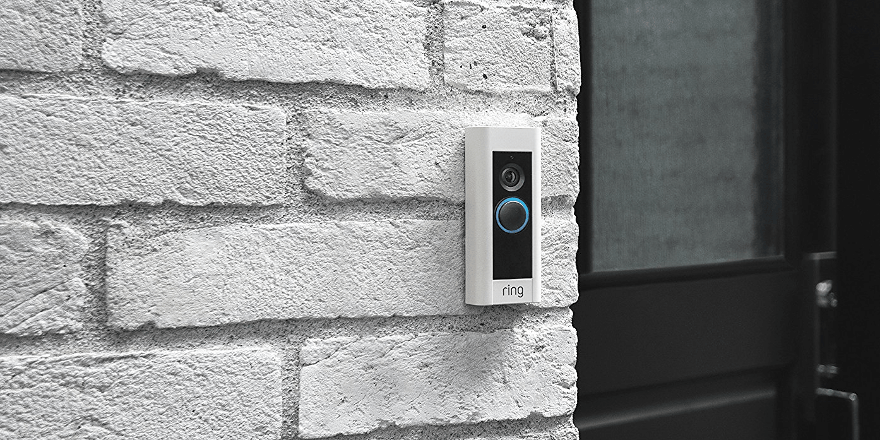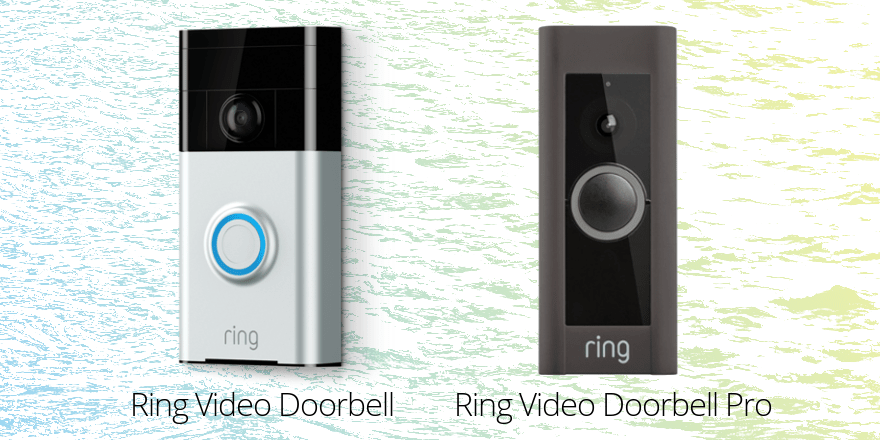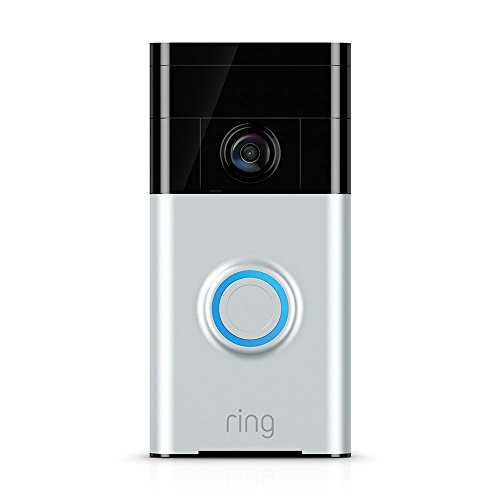If you’re looking to replace your traditional doorbell with a smart video doorbell, Ring’s got you covered. They offer quality alternatives to traditional doorbells with added security and convenience. We’ll take a look at two Ring doorbells: the Ring vs the Ring Pro.
About Ring Doorbells
Ring is committed to reducing crime, and a doorbell that doubles as a monitoring system will allow you to answer your door with confidence and keep track of anyone that approaches your home.
In addition to great security features, you can take advantage of Ring’s support for two-way audio, allowing you to talk with visitors via the mobile app when you can’t make it to the door.
You can buy in confidence knowing that Ring will replace your doorbell if it’s ever stolen. Rest assured that your home will continued to be protected for the years to come.
Ring vs. Ring Pro — Common Features

- Both devices can alert you instantly when someone rings the doorbell or motion is detected. Two-way audio and live video feeds allow you to listen and speak to visitors using a Wi-Fi connection.
- Support for Night vision ensures your home will be monitored and protected from dusk til dawn, and you can manage your devices with ease using the control center app for iOS, Android, or Windows 10.
- Simple installation and integration with Amazon Echo Show makes it easy to get your doorbell up and running, as well as connected to your smart home. Apple Homekit compatibility is also in the works, and will further enhance all Ring devices’ connectivity and integration with the rest of your devices.
Ring vs. Ring Pro — Differences
- Difference #1: Video resolution – Although both devices record HD video, the Ring Pro has the advantage with a 1080p resolution compared to the Ring’s 720p. A better image can offer more peace of mind by ensuring that all the details of recordings are saved in high quality.
Plus, who doesn’t prefer video in hd?
- Difference #2: On-demand live video – Both devices feature on-demand live video, but the Ring doorbell only offers this feature when hardwired. If you power the Ring doorbell via battery, the on-demand live video will not be available.
The Ring Pro, on the other hand, will always give you access to on-demand live video, and here’s why:
- Difference #3: Power options – The Ring Pro always gives access to on-demand live video — because it requires hardwiring to function. With a constant power supply, it can be active 24/7. The lack of an option for battery power is disappointing, but it’s likely due to its slick new dimensions (more on that in the next difference).
The Ring can be hardwired, but also offers the option for rechargeable battery power. A single charge of the battery will last you 6-12 months without any need for a charge. But, when it does need some more juice, it can be a bit of a hassle. Charging the Ring requires you to basically remove the whole device from your door and bring it inside for charging via micro-USB — which makes the Ring a little higher maintenance.
Both models have their downsides when it comes to power options. If you don’t have access to existing doorbell wiring, or you don’t feel comfortable hooking it up yourself, the Ring Pro might not be the best fit.
On the other hand, the rare occasions that you need to charge the Ring’s battery seem to be more hassle than it’s worth.
So, depending on your home’s setup you can choose the doorbell that will work with your setting.
- Difference #4: Design – The two devices also differ in their design. The Ring, being an older model, is bulkier with dimensions of 4.98 x 2.43 x 0.87 inches. It’s way wider than the Ring Pro.
The Ring Pro is slimmer at 4.5 x 1.85 x 0.80 inches, and sleeker with a silver-looking bezel. As a piece of smart technology that easily blends into your home aesthetic, it looks much more like a regular doorbell rather than a clunky, bulky device attached to your entryway.
- Difference #5: Field of view – The Ring actually features a wider field of view when compared to the Ring Pro, with 180 degree horizontal and 140 vertical view.
The Ring Pro has a 160 degree horizontal and 100 degree vertical field of view. While this may be more than enough for the majority of situations, the Ring gives you access to a more comprehensive view of the area around your front door.
Surprisingly, the Ring comes out on top in this difference.
- Difference #6: Compatible networks – While both the Ring and Ring Pro can run off of 2.4 GHz 802.11 b/g/n Wi-Fi, the Ring Pro also supports a 5 GHz connection which is generally considered a better frequency with less interference with other Wi-Fi devices.
This 5 Ghz option gives the Ring Pro the edge in this difference.
- Difference #7: Motion detection– The Ring features basic motion detection, a technology which is also present in , and Ring Video Doorbell 2. This tech is designed to detect human-sized heat signatures up to 30 feet away using passive infra-red (PIR). While this may sound difficult to set up, it’s easily configurable using the “range bar” in the Ring app on your mobile device.
The Ring Pro features advanced motion detection that captures an image and uses it as a reference. Motion zones with up to 8 customizable points will alert you when the pixels of the saved image change. Any time the doorbell’s view varies from the norm, you’ll receive a convenient alert to keep you aware of any new activity.
The Ring Pro seems like a significant step up from the Ring when it comes to motion detection.
- Difference #8: Silent mode – If you power either device via a hardwire connection, the Ring and Ring Pro will activate your pre-existing door chime.
There’s no way to disable this with the Ring, but you can avoid this issue by running it off of the rechargeable battery.
The Ring Pro offers the ability to put your doorbell on “silent mode” to avoid activating a chime.
- Difference #9: Colors – If you purchase the Ring, you’ll have the option to choose from four different finishes for your device: Antique Brass, Polished Brass, Satin Nickel, and Venetian Bronze.
The Ring Pro offers a little more customization with interchangeable faceplates. 4 different colors are included with the Pro, allowing you to change the style of your device without having to buy a brand new unit.
Ring vs. Ring Pro — Comparison Chart
| Ring Video Doorbell | Ring Video Doorbell Pro | |
|---|---|---|
| Power Options | Battery/Hardwired | Hardwired |
| Battery Life | 6-12 months | — |
| Compatible Doorbell Transformers | 8-24 VAC, DC not compatible |
16-24 VAC, DC not compatible |
| Field of View | 180 degrees horizontal, 140 degrees vertical |
160 degrees horizontal, 100 degrees vertical |
| Video Resolution | 720p HD | 1080p HD |
| Night view | Yes | Yes |
| Color Night Vision | No | No |
| Compatible Networks | 2.4 GHz 802.11 b/g/n | 2.4/5 GHz 802.11 b/g/n |
| Motion Detection | Basic | Advanced |
| Live View Motion Triggered | Yes | Yes |
| Live View On Demand | Only if Wired | Yes |
| Size | 4.98 x 2.43 x 0.87 inches 12.65 x 6.17 x 2.21 cm |
4.5 x 1.85 x 0.80 inches 11.43 x 4.7 x 2.03 cm |
| Mounting Screws | 4 | 2 |
| Security Screws | 2 | 1 |
| Silent Mode | No | Yes |
| Two-Way Audio | Yes | Yes |
| Operating Temperature | -5 – 120°F (-20 – 50°C) | -5 – 120°F (-20 – 50°C) |
| Web App | Yes | Yes |
| Colors | Available in four finishes | Includes 4 faceplates |
Ring Video Doorbell Subscription Plans
A majority of smart home monitoring systems have some sort of subscription plan, and Ring is no exception. The plans are not obligatory, but if you don’t use them it kinda makes you question why you’d get a smart doorbell on the first place. Basically, it’s becoming standard to lock “smart” features behind subscription plans.
So, the first subscription is No subscription. Not having a subscription will only allow you to get alerts to your smartphone when visitors ring your smart doorbell or the motion sensors are triggered. That’s pretty much it.
The Ring Protect Basic Plan gives you 60 days of storage for your Ring Doorbell video recordings. Yes, you can record videos, review videos from missed alerts, and even share the videos by simply clicking on a share button. And all of it for just $3 a month, or $30 dollars a year, per doorbell.
The high end subscription is the Ring Protect Plus — it makes sense to upgrade to this plan if you have more than 3 Ring devices, because the Protect Plus covers an unlimited number of Ring devices. The Plus plan offers all the benefits of the Basic plan, plus exclusive discounts and a lifetime warranty (in the event that an inconsiderate person steals your doorbell, Ring will replace it for free). The Ring Protect Plus Plan is $10 a month or $100 a year.
If you don’t really feel like paying for a subscription plan, we suggest that you check out the Skybell HD doorbell (doesn’t have subscription plans at all), or Arlo cameras if surveillance is your main goal (7 days free storage, which we’ve found to be more than enough).
| Basic | Protect | |
|---|---|---|
| Cost | $30 per camera per year or $3 per month | $100 per year or $10 per month. |
| Ring Protect system monitoring | No | Yes, 24/7 |
| Additional charge for extra cameras | Yes | No, Unlimited cameras |
| Stream Audio & Video | Yes | Yes |
| Live View | Yes | Yes |
| Lifetime Theft Protection | Yes | Yes |
| Cloud Storage | Yes | Yes |
| Video Review | Yes | Yes |
| Video Sharing | Yes | Yes |
| Event Saving | Yes | Yes |
| Warranty | 1-year Warranty | Lifetime Warranty |
| Exclusive Discounts | No | Yes |
Ring vs. Ring Pro — Our Thoughts

The Ring Pro offers some more advanced features, better video quality, and advanced motion detection, but doesn’t offer simple installation; the Ring Pro lacks the battery power option available to the original Ring. However, if you already have a wired doorbell, then the installation isn’t all too hard. Plus, you can always order a Ring Video Doorbell Pro Installation from Amazon if you don’t feel like taking on the wiring project yourself.
No products found.
The Ring lacks features like advanced motion detection and 1080p video, but if you’re looking for a wider field view and a battery power option, then the Ring Doorbell is the one to go for.
And if neither option sounds all that enticing, check out our Smart Doorbell page to see our comparison chart for other smart doorbells on the market.
Last update on 2024-04-18 at 02:11 / Affiliate links / Images from Amazon Product Advertising API




